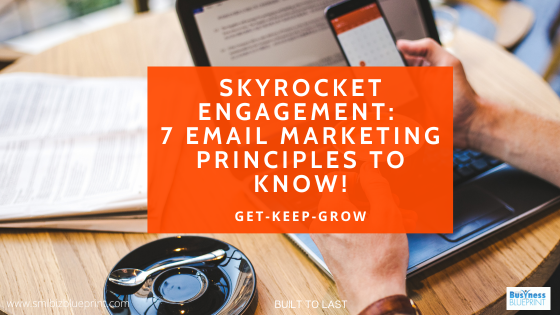Email marketing remains a titan in the marketing mix, offering unmatched direct access to your audience.
As a business owner, mastering this channel can yield an impressive return on investment.
This article unlocks the core practices that drive successful campaigns.

Implement these principles, backed by persuasive reasoning and proven methods, and watch your engagement soar.
#1 Crafting an Efficient Opt-In Process
Creating an opt-in process isn’t merely about capturing an email address; it’s about starting a conversation.
A successful opt-in form greets new subscribers with ease and anticipation.
Provide a compelling reason for visitors to subscribe, whether an exclusive offer or an insightful newsletter. Design your form simply, limiting fields to only the most essential information.
Specific Example: Imagine a ‘10% off your next purchase’ prompt appearing as a visitor browses your collection of artisanal coffee blends. That’s an incentive bound to brew subscriber interest.
Next Steps
Simplify Sign-up Forms: Keep your sign-up forms short and straightforward. Ask for essential information only—like name and email—to increase the likelihood of subscription.
Use Strong Lead Magnets: Offer a valuable and relevant lead magnet, such as a free ebook, a discount code, or an exclusive report, to incentivise sign-ups.
Implement Double Opt-in: Use a double opt-in process to ensure that the subscribers are genuinely interested in your emails, which helps maintain a high-quality subscriber list.
#2 Mastering Subject Line Success
The subject line is the gatekeeper of your email. It determines whether your message is welcomed or turned away into the digital abyss.
Successful subject lines blend urgency, curiosity, and relevance.
They should promise and deliver clear value. Use actionable language that spurs the reader to open the email.
Practical Application: Test subject lines like “Unlock Your Monday Exclusive” against “Your Exclusive Discount Awaits!” to see which garners more opens.
Next Steps
Arouse Curiosity: Craft subject lines that pique the reader’s interest, using teasers that prompt them to open the email to learn more.
Personalize: Include the subscriber’s name or references to their past behaviour to catch their attention and make the email feel tailored to them.
Test and Refine: Regularly perform A/B testing on your subject lines with segments of your email list to see which phrases yield higher open rates.
#3 A/B Testing to Perfect Your Pitch
A/B testing is your scientific method in the art of email marketing. By sending two variations to a small segment of your list, you gather valuable data on preferences and behaviours.
Test one variable at a time, be it the subject line, call to action, or design layout, and use the results to refine your approach.
Case Study: A fashion retailer tests two email versions to determine the more effective CTA. “Shop Now” versus “Discover Your Style” results in a 20% higher click-through rate for the latter, driving a pivot in strategy.
Next Steps
Test One Variable at a Time: Change only one element of the subject line for each test to measure the impact of that single change accurately.
Significant Sample Size and Testing Duration: Use a large enough segment of your subscribers and run the test over a sufficient time to collect meaningful data.
Document and Apply Learnings: Record the results from each test, analyse patterns, and apply this knowledge to future subject lines.

#4 Regular Email List Cleaning
An engaged list is more valuable than a large one. Regularly remove inactive subscribers to maintain a robust engagement rate.
Send a re-engagement campaign before purging to confirm disinterest. A clean list reduces costs and improves the relevance of your metrics.
How-to: Utilize your email provider tools to track subscriber engagement and schedule periodic list cleaning.
Next Steps
Monitor Engagement: Keep an eye on which subscribers are inactive and segment them into a re-engagement campaign, or consider removing them if they remain disengaged.
Verify Emails Upon Sign-up: Use email verification tools at the point of sign-up to prevent fake or incorrect email addresses from being added to your list.
Set Up a Re-engagement Campaign: Before removing inactive users, try to win them back with a special offer or a personalised message.
#5 Metrics That Matter in Email Marketing
To gauge the health of your campaigns, key metrics such as open rate, click-through rate, and conversion rate must be in your arsenal.
These figures will guide your content and strategy adjustments.
Illustration: A newsletter with an industry news roundup sees a high open rate but a low click-through rate. This data suggests readers are curious but not compelled to act, prompting a strategic shift.
Next Steps
Define Key Performance Indicators (KPIs): Determine which metrics matter most to your campaign goals—open rates, click-through rates, or conversion rates.
Regular Review: Schedule weekly or monthly reviews of these metrics to assess the performance of your campaigns and identify trends.
Segment and Target: Break down your metrics by audience segment to tailor future emails more precisely to each group’s needs and behaviours.
#6 Subscription Magnets: Creative Ways to Grow Your List
Creativity wins in the crowded marketplace of inboxes. Offer a free ebook, host a webinar, or provide an email course.
Provide immediate value that resonates with your prospects’ needs.
Real-World Example: An online learning platform offers a free webinar on digital marketing trends, resulting in a 50% increase in newsletter sign-ups.
Next Steps
Exclusivity in Content: Provide content that can only be accessed through email subscriptions, such as insider tips, early product releases, or exclusive updates.
Social Proof: Showcase testimonials from satisfied subscribers or case studies of how your content has benefited others to encourage new sign-ups.
Visibility of Sign-up Opportunities: Place your sign-up CTA prominently on your website, social media profiles, and at the end of blog posts to ensure potential subscribers see it.

#7 Emailing Rhythms: Finding the Right Frequency
Finding the sweet spot for email frequency keeps your brand top of mind without irking subscribers. It varies by industry and audience, so test what works for your list.
Insight: A monthly newsletter may suffice for a consultancy firm, while a weekly update is more suitable for a high-traffic e-commerce site.
Next Steps
Subscriber Preferences: Give subscribers control over how often they hear from you by offering options at the point of sign-up.
Consistency is Key: Maintain a regular sending schedule so subscribers know when to expect your emails, which can build anticipation and trust.
Analyse and Adapt: Monitor engagement rates relative to email frequency to find your optimal schedule. Adjust based on seasons, promotions, or subscriber feedback.
Must Haves:
A Streamlined Opt-in Strategy:
Have a clear and compelling value proposition displayed prominently on your opt-in forms.
Use a double opt-in mechanism to verify subscriber email addresses and maintain list quality.
Incorporate welcome emails that set the tone for future communication and reaffirm the subscriber’s decision to join your list.
Effective Email Subject Lines:
Utilise personalisation to tailor emails to the individual, increasing their chance of being opened.
Employ actionable language that encourages subscribers to take a specific action, like “Discover,” “Learn,” or “Grab your seat” for events or webinars.
Test different subject lines using A/B testing to refine and improve their effectiveness based on subscriber response continually.
Consistent List Maintenance:
Conduct regular audits of your email list to remove inactive subscribers and keep your engagement rates healthy.
Implement segmentation to ensure the content is relevant to the different groups within your subscriber base.
Create targeted re-engagement campaigns for those who haven’t interacted with your emails recently before considering removing them from your list.
Additional Options
Incorporate User-Generated Content:
Encourage subscribers to send in their own content related to your product or service, which you can feature in your campaigns. This not only provides fresh, relatable content but also fosters a sense of community and co-creation among your audience.
Email Signature Marketing:
Utilise the space in your email signature for marketing purposes. This can include your latest offers, a call to action for a webinar, or a new product announcement. It’s a low-effort, subtle method that places your message in every one-on-one email sent from your company.
Gamification Techniques:
Apply gamification elements to your emails, like quizzes, polls, or contests, which can increase interaction and make the experience more engaging for subscribers. This could also include scratch cards for discounts or special offer reveals, adding an element of fun and surprise to your campaigns.
Conclusion
Solidify your place in your customers’ inboxes with these six principles. They are strategies and the foundation of a potent email marketing operation. Implement them, and set your brand apart.
Now, take your next step: evaluate your email strategy, apply these insights, and continue to refine your approach for breakthrough results.
Frequently Asked Questions
Q1: How can I improve my email open rates?
A1: To improve your email open rates, craft compelling subject lines that spark curiosity and demonstrate clear value. Personalise your emails and segment your lists to target specific subscriber interests. Timing is also crucial; find the best time to send emails through testing and analytics.
Q2: What are some successful opt-in incentives?
A2: Successful opt-in incentives could include exclusive discounts, free trials, informative ebooks, or access to webinars. These incentives should offer immediate value and be relevant to the interests of your target audience.
Q3: How often should I clean my email list?
A3: It’s recommended to clean your email list at least once every six months to remove unengaged subscribers. This helps maintain a healthy sender reputation and ensures your content reaches those most interested in your brand.
Q4: What metrics should I prioritise in my reports?
A4: Prioritize open rates, click-through rates, conversion rates, and bounce rates in your reports. These metrics provide insight into your audience’s behaviour and the effectiveness of your email campaigns.
Q5: How do I balance content and sales pitches in my emails?
A5: Balance content and sales pitches by following the 80/20 rule, where 80% of your content provides value and education, while only 20% focuses on promotions and sales. This balance can build trust and foster a relationship with your subscribers.
Q6: What makes an email subject line effective?
A6: An effective email subject line is clear, concise, and engaging. It should use action verbs, create a sense of urgency or curiosity, and be personalised when possible. Avoid spammy words that might trigger filters.
Q7: How can A/B testing improve my email engagement?
A7: A/B testing can significantly improve email engagement by allowing you to understand what resonates best with your audience. By testing different subject lines, email content, and send times, you can refine your strategy for better results.




